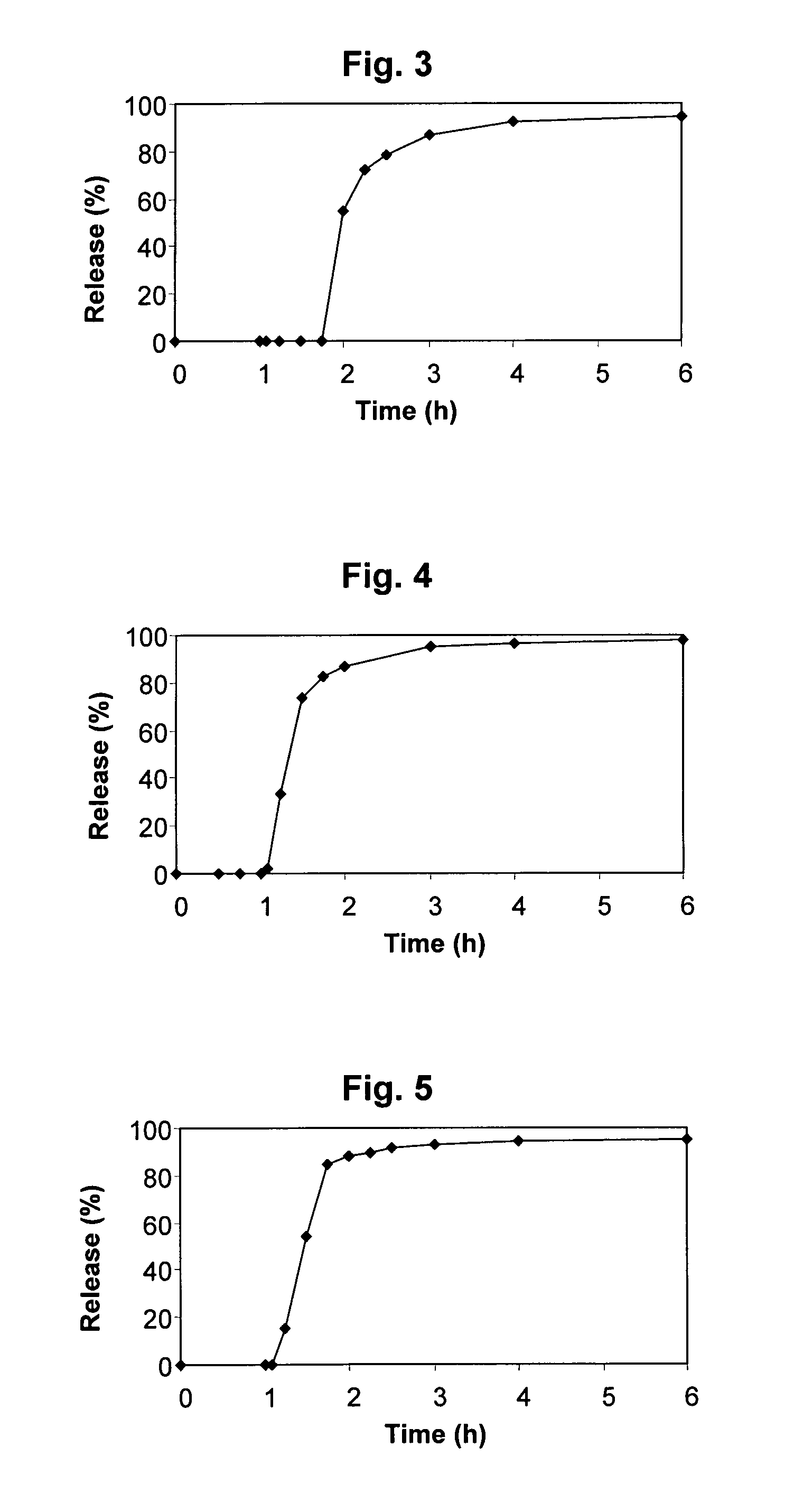Release of statins in the intestine
a statin and intestine technology, applied in the field of statin release in the intestine, can solve the problems of low permeability through the mucosal membrane, poor bioavailability of simvastatin, and significant amount of active ingredients in the core, and achieve the effect of improving bioavailability
- Summary
- Abstract
- Description
- Claims
- Application Information
AI Technical Summary
Benefits of technology
Problems solved by technology
Method used
Image
Examples
example 1
Materials and Methods
A. Core Types:
[0270]1—Simvastatin 8 mg, 2% Colloidal silicon dioxide, weight 250 mg;
[0271]2—Simvastatin 10 mg, 2% Colloidal silicon dioxide, weight 300 mg;
[0272]3—Simvastatin 16 mg, 2% Colloidal silicon dioxide, weight 300 mg;
[0273]4—Simvastatin 10 mg, 0.71% Colloidal silicon dioxide, weight 316 mg;
[0274]5—Simvastatin 10 mg, 1.5% Colloidal silicon dioxide, weight 300 mg;
[0275]6—Simvastatin 10 mg, 2% Colloidal silicon dioxide, weight 300 mg;
[0276]7—Simvastatin 10 mg, 1.5% Colloidal silicon dioxide, 1.33% Sodium lauryl sulphate (SLS), weight 300 mg;
[0277]8—Simvastatin 20 mg, 1.5% Colloidal silicon dioxide, in a geometrical relation of 2 / 1 with type 5 cores, weight 600 mg;
[0278]9—Simvastatin 20 mg, w / o Silicon dioxide, 10% Crospovidone, weight 300 mg;
[0279]10—Simvastatin 20 mg, 1.5% Colloidal silicon dioxide, weight 300 mg;
[0280]11—Simvastatin 20 mg, 2% Colloidal silicon dioxide, weight 300 mg;
B. Coating Types:
[0281]A—TCDS coating (Microcrystalline cellulose PH 102...
example 2
Residual Active Material in the TCDS Coat After Total Disintegration of the Tablet
[0351]The TCDS coating film is composed of a combination of a hydrophobic water-insoluble polymer in which water-insoluble but hydrophilic particles are embedded. The hydrophobic polymer, however, may trap a fraction of the active material existing at the interface between the TCDS coat and the surface of the core, and thus prevent the active material from being released even after total disintegration of the tablet occurs. This is particularly relevant for that group of active materials whose solubility in water or aqueous solutions is relatively low. The solubility of Simvastatin is relatively low; therefore, it can be entrapped in the hydrophobic water-insoluble part of the TCDS coat rather than being totally released. This may be more critical when the disintegration of the coated tablet takes place where the amount of water is relatively low, such as in the colon, and then the bioavailability and ...
example 3
Dissolution Results
[0356]Tables 14-34 hereinbelow present the results of dissolution tests performed on test formulations 1-A, 2-A, 3-A, 4-B, 4-C, 5-A, 5-B, 5-C, 5-D, 6-D, 6-E, 7-A, 7-B, 7-C, 8-A, 8-D, 9-A, 9-B, 10-D, 11-D and 11-E, respectively, as described in Example 1 herein. FIGS. 3-23 are graphic representations of these results, wherein the accumulative release of Simvastatin (%) is presented as a finction of time (h).
[0357]Six tablet samples of each formulation, designated T1 to T6, were examined in each experiment. The mean values obtained for all six samples are designated “T-T6” in Tables 14 through 34.
TABLE 14Dissolution test results - Simvastatin accumulativerelease (%) - Formulation 1-AHoursT1T2T3T4T5T6T1-T600000000.01.080.00.00.00.00.00.00.01.250.00.00.00.00.00.00.01.50.00.00.00.00.00.00.01.750.00.00.00.00.00.00.0253.349.566.229.764.967.455.22.2565.372.775.365.275.778.272.12.570.979.882.571.181.884.178.4379.487.289.878.789.495.786.7493.192.291.787.093.297.692.5693.793...
PUM
| Property | Measurement | Unit |
|---|---|---|
| transit time | aaaaa | aaaaa |
| delay time | aaaaa | aaaaa |
| solubility | aaaaa | aaaaa |
Abstract
Description
Claims
Application Information
 Login to View More
Login to View More - R&D
- Intellectual Property
- Life Sciences
- Materials
- Tech Scout
- Unparalleled Data Quality
- Higher Quality Content
- 60% Fewer Hallucinations
Browse by: Latest US Patents, China's latest patents, Technical Efficacy Thesaurus, Application Domain, Technology Topic, Popular Technical Reports.
© 2025 PatSnap. All rights reserved.Legal|Privacy policy|Modern Slavery Act Transparency Statement|Sitemap|About US| Contact US: help@patsnap.com



